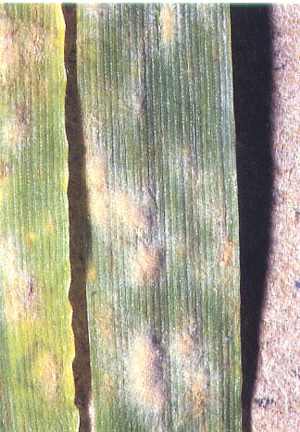Diseases
Blumeria graminis f. sp. hordei - Powdery mildew of barley
Systematic position:
Class: Ascomycetes, subclass Euascomycetes, order Erysiphales, family Erysiphaceae, genus Blumeria.Biological group:
Obligate pathogen of barley and other wild and cultivated species of Hordeum.Biology and morphology:
Powdery mildew of barley caused by Blumeria graminis f. sp. hordei is restricted to the genus Hordeum and does not attack other small grain cereals. The infection reduces functional green leaf area, thereby reducing grain yield, kernel weight, grain protein, the number of tillers and heads, and root growth. The pathogen attacks all aerial parts of plant, being usually most prevalent on the upper surface of leaves. Superficial mycelium and conidia sporulation give the leaves a powdery appearance. Conidia develop on terminal generative cells of short and simple conidiophores. Conidia are hyaline, unicellular, ellipsoidal to ovate (8-10 x 25-30 mkm). They are produced basipetally and diurnally in long chains. This conidial state is named Oidium monilioides (Nees) Link. The haustoria (5-10 x 10-30 mkm) bear distinct fingerlike appendages up to 20 mkm in length at each apex. Mycelium grows only on the surface of plant tissues, never invading the tissues themselves. The germ tubes penetrate barley directly, establish haustoria in epidermal cells, and give rise to superficial sporulating colonies. Fungus is heterothallic, and two mating types occur in about equal frequency in natural populations. Cleistothecia are composed of interlaced light-colored mycelium. After maturation they become dark and sunken, with sparingly branched appendages on their surface. Mature cleistothecia are globose, 135-280 mkm in diameter. Asci are numerous (15-20 per cleistothecia). Mature asci are cylindrical to ovate (25-40 x 70-110 mkm. There are 8 hyaline ascospores (10-13 x 20-23 mkm) in each ascus.Distribution:
Disease is widely distributed throughout the world. In NIS countries occurs everywhere in areas of barley cultivated.Ecology:
On the territory of Russia in areas with moderate winter climate the causal agent of powdery mildew is able to survive as mycelium and conidia in green tissue of winter barley host. The sexual stage of the fungus is essential for survival in the regions of spring barley production (North-West, Ural Regions, and Siberia). Cleistothecia with ascospores are formed on older leaves as the plants mature. Low temperatures and cleistothecia wetting for at least 72 hr. induce the maturation of ascospores. Sexual recombination and mutation increase genetic diversity in the pathogen population, resulting in new virulence types. Windborne ascospores or conidia serve as the primary inoculum. Airborne infection can move across European and Asian parts of NIS countries. Conidia germinate over a wide range of temperatures (1-30.C) even without free moisture; however germination optimum is 100% relative humidity. Incubation period is 7 to 10 days under favorable field conditions (15-22.C).Economic significance:
Powdery mildew of barley is the most important disease in the Central Chernozem, Non-Chernozem Regions of Russia, Western Siberia, also in Belarus, Moldova, Ukraine, Kazakhstan, Kirgizia. Epidemics can occur 2-3 times during 10 years. Yield losses depend on the disease severity and can reach 10-36%.Related References:
Andryushchenko A.V., Vinnichuk T.S., Toropkova L.I. 1990. Phythosanitary condition of grain crops, cultivated on intensive technology in condition of North Forest-steppe and Polesia of Ukraine. // Zashchita rastenii v usloviyakh intensifikatsii s.-kh. Ukrainskoi SSR. Sbornik nauchnykh trudov. Kiev. P. 41-43 (in Russian).Dzhiembaev Z.T. 1974. Powdery mildew of cereals in Kazakhstan // Zashchita zernovykh kul.tur ot vreditelei, boleznei i sornyakov. Alma-Ata: Kainar. P. 135-139.
Gavare L.A. 1979. Harmfulness of barley powdery mildew in Latviskaya SSR. Mikologiya I fitopatologiya. V. 13. T. 5. P. 399-401 (in Russian).
Ishkova T.I., Berestetskaya L.I., Gasich E.L., Levitin M.M., Vlasov D.U. 2000. Diagnostics of the main diseases of cereals. Saint Petersburg: VIZR. 76 P. (in Russian).
Kobakhidze D.M. 1971. Powdery mildew of cereal crops. Rasprostranenie vreditelei I boleznei s.-kh. kul.tur v RSFSR v 1970 i prognoz ikh poyavleniya v 1971. Moscow: MSKh SSSR. P. 113-115. (in Russian).
Lazu M.N. 1991. Fungal diseases severity of winter crops on the different elements of a relief. Izvestiya AN SSR Moldova. Biologicheskie i Khimicheskie nauki. N 2. P. 69-73 (in Russian).
Mathre D.E. (Edit.). 1997. Compendium of barley diseases. APS PRESS. 90 p.
Nikulina N.K., Elbakyan M.A., Shchekochikhina R.I. 1967. Powdery mildew and other fungal diseases of cereals. Rasprostranenie vreditelei I boleznei s.-kh. kul.tur v RSFSR v 1966 i prognoz ikh poyavleniya v 1967. Moscow: MSKh SSSR. P. 78-79 (in Russian).
Novozhilov K.V., Zakharenko V.A. (Eds.). 2000. Levels and tendencies of variability of species composition and intrapopulation structure, areas of complexes of harmful and useful organisms and forecast of dangerous phytosanitary situations in zones of the country. St.-Petersburg. 100 P. (in Russian).
Peresypkin V.F. 1969. Agricultural Phytopathology. Moscow: Kolos, 479 P. (in Russian).
Sanin S. S. 1995. Phytosanitary monitoring: modern state and ways of improvement. In book: Problems of Optimization of Phytosanitary State in Plant Industry. Sbornik trudov Vserossiiskogo s.ezda po zashchite rastenii. St.- Petersburg. P. 166-175 (in Russian).
Sanin S.S., Makarov A.A. 1999. Biological, agroecological, and economical aspects of phytosanitary monitoring. Plant Protection News. P. 62-66 (in Russian).
Shopina V.V., Chumakov A.E. 1972. Powdery mildew of cereal crops. Rasprostranenie boleznei s.-kh. kul.tur v SSSR v 1968 . 1972 g. Moscow. P. 38-79.


